package com.example.switchyard.docs;
import org.switchyard.component.bean.Service;
@Service(Example.class)
public class ExampleBean implements Example {
}
Bean Services
Overview
The Bean Component is a pluggable container in SwitchYard which allows Java classes (or beans) to provide and consume services. This means that you can implement a service by simply annotating a Java class. It also means you can consume a service by injecting a reference to that service directly into your Java class. Rather than writing our own POJO container to provide this capability, we have implemented the bean component as a Weld extension. No need to learn a new programming model - bean services are standard CDI beans with a few extra annotations. This also opens up the possibilities of how SwitchYard is used; you can now expose existing CDI-based beans in your application as services to the outside world or consume services within your bean
Creating a Bean Service
To create a new Bean service you only need a few pieces of information:
-
Name : the name of the Java class for your bean service.
-
Service Name : the name of the service your bean will provide.
-
Interface : the contract for the service being provided. Java is the only valid interface type for bean services.
Note that starting with the interface value will default the names for Name and Service Name, which can speed things up if you're in a hurry.
After clicking Finish, you will have a new class that looks something like this:
The @Service annotation allows the SwitchYard CDI Extension to discover your bean at runtime and register it as a service. The value of the annotation (Example.class in the above example) represents the service contract for the service. Every bean service must have an @Service annotation with a value identifying the service interface for the service.
To complete the definition of your service, add one or more operations to the service interface and provide a corresponding implementation in your bean:
package com.example.switchyard.docs;
import org.switchyard.component.bean.Service;
@Service(Example.class)
public class ExampleBean implements Example {
public void greet(Person person) {
// implement service logic here for greet operation
}
}
Consuming a Service
In addition to providing a service in SwitchYard, beans can also consume other services. These services can be provided in the same application by other implementations, or they could be wired to gateway bindings to invoke services over JMS, SOAP, FTP, etc. The SwitchYard runtime handles the resolution of the service reference to a concrete service, allowing your service logic to remain blissfully ignorant. Invocations made through this reference are routed through the SwitchYard exchange mechanism.
Consuming a SwitchYard service from within a CDI bean is done via @Reference annotations.
@Service(ConsumerService.class)
public class ConsumerServiceBean implements ConsumerService {
@Inject
@Reference
private SimpleService service;
public void consumeSomeService(String consumerName) {
service.sayHello("Hello " + consumerName);
}
}
By default, SwitchYard expects a service reference to be declared with a name which matches the Java type used for the reference. In the above example, the SimpleService type would require a service reference in your SwitchYard configuration called "SimpleService". In the event where the service reference name is different from the type name of the contract, the @Reference annotation can accept a service name:
@Reference("urn:myservices:purchasing:OrderService")
private OrderService orders;
ReferenceInvoker
The default behavior of @Reference is to inject a reference using the Java interface of the reference contract (SimpleService in the above example). This is adequate for most cases, but it does not allow you to access SwitchYard API constructs like the Message and Context interfaces. If you need to access to an attachment or a context property when invoking a reference from a Bean service, then you will want to use a ReferenceInvoker. To use a ReferenceInvoker, all you need to do is replace the service contract interface type with a ReferenceInvoker type and SwitchYard will automatically inject the correct instance. Here's a revised example which uses a ReferenceInvoker instance to invoke "SimpleService":
@Inject
@Reference("SimpleService")
private ReferenceInvoker service;
public void consumeSomeService(String consumerName) {
service.newInvocation("sayHello")
.setProperty("myHeader", "myValue")
.invoke(consumerName);
}
Note how the ReferenceInvoker instance is used to create a ReferenceInvocation using the newInvocation() method. A new instance of ReferenceInvocation should be created each time you want to invoke a service using ReferenceInvoker.
Invocation Properties
While it's a best practice to write your service logic to the data that's defined in the contract (the input and output message types), there can be situations where you need to access contextual information like message headers (e.g. received file name) in your implementation. To facilitate this, the Bean component allows you to access the SwitchYard Exchange Context instance associated with a given Bean Service Operation invocation. To get a reference to the Context, simply add a Context property to your bean and annotate it with the CDI @Inject annotation.
@Service(SimpleService.class)
public class SimpleServiceBean implements SimpleService {
@Inject
private Context context;
public String sayHello(String message) {
System.out.println("*** Funky Context Property Value: " + context.getPropertyValue("funkyContextProperty"));
return "Hi there!!";
}
}
The Context interface allows your bean logic to get and set properties in the context. Note that you can only make calls on the Context instance within the scope of one of the Service Operation methods. Invoking it outside this scope will result in an UnsupportedOperationException being thrown.
Implementation Properties
In contrast to invocation properties, implementation properties represent environmental properties that you have defined in the SwitchYard application descriptor (switchyard.xml) for your bean implementation. To access these properties, simply add an @Property annotation to your bean class identifying the property you want to inject. The following example demonstrates injection of a "user.name" property:
@Service(SimpleService.class)
public class SimpleServiceBean implements SimpleService {
@Property(name="user.name")
private String name;
public String sayHello(String message) {
return "Hello " + name + ", I got a message: " + message;
}
}
See the Properties section of the User Guide for more information about SwitchYard property support.
Fault propagation on IN_ONLY
If the MEP of the service is IN_ONLY, Bean service just ignores the fault by default. If you want to propagate the fault back to service consumer, then you need to use IN_OUT MEP instead, or set "org.switchyard.propagateExceptionOnInOnly" property to true in your application domain. Domain properties are set via entries in the <domain> section of switchyard.xml.
<domain>
<properties>
<property name="org.switchyard.propagateExceptionOnInOnly" value="true"/>
</properties>
</domain>
Camel Services
Overview
Camel services allow you to leverage the core routing engine inside of Apache Camel to route between services in SwitchYard. All of the EIP and core routing support in Camel is available to your service implementation. Each Camel route is exposed as a service within SwitchYard, which means it has a well-defined contract and can be injected into any other service in the runtime.
Creating a Camel Service
The first thing you need to decide when you create a Camel routing service is whether you want to use the Java DSL or XML dialect for the route. Functionally, they are more or less equivalent, so it's more a choice of how you want to express your routing logic. If you want create a Java DSL route, select the "Camel (Java)" implementation type. For XML, use the "Camel (XML)" type. Regardless of which language you choose, the following information is required:
-
Name : the name of the Java class or XML file for your bean service.
-
Service Name : the name of the service your bean will provide.
-
Interface : the contract for the service being provided. Camel supports Java, WSDL, and ESB contract types.

For details on each type of Camel route, see the Java DSL Routes and XML Routes sections below. You can have multiple routing services per application, each with it's own routing language (e.g. an application can have two Java DSL routes and one XML route). There are some general guidelines to keep in mind with both types of routes:
-
There is only one route per service.
-
The consumer or "from" endpoint in a route is always a "switchyard" endpoint and the endpoint name must equal the service name. This is default behavior in the tooling.
-
To consume other services from within your route, only use "switchyard" consumer (i.e. "to") endpoints. This keeps your routing logic independent of the binding details for consumed services.
Java DSL Routes
A newly created Java DSL route looks like this:
package com.example.switchyard.docs;
import org.apache.camel.builder.RouteBuilder;
public class CamelServiceRoute extends RouteBuilder {
/**
* The Camel route is configured via this method. The from:
* endpoint is required to be a SwitchYard service.
*/
public void configure() {
// TODO Auto-generated method stub
from("switchyard://Example").log(
"Received message for 'Example' : ${body}");
}
}
There are no SwitchYard-specific classes or APIs used for Java DSL routes; the route class is identical in signature to what you would use with Apache Camel directly. Since there is one route per service, you will have one RouteBuilder class for each Camel routing service in your application. To add logic to your routing service, simply add additional logic to the configure() method. For background and details on what you can do with the Java DSL, please consult the Apache Camel documentation.
XML Routes
A newly created XML route looks like this:
<?xml version="1.0" encoding="ASCII"?>
<route xmlns="http://camel.apache.org/schema/spring">
<from uri="switchyard://Example"/>
<log message="Example - message received: ${body}"/>
</route>
Like Java DSL routes, the XML routing syntax is identical to what you would use with Apache Camel directly and conforms to the Camel schema for <route> definitions. There will be one file containing a route definition for each XML routing service in your application.
Consuming Services From Camel Routes
Invoking another service from within your Camel route can be done by using the SwitchYard producer endpoint (switchyard://) within your route. Endpoint configuration is very straightforward:
switchyard://[service-name]?operationName=[operation-name]
-
service-name : name of the SwitchYard service. This value needs to match the name of a service reference defined on the service component for the route.
-
operation-name : name of the service operation to be invoked. This is only used on references and is optional if the target service only has a single operation.
A modified version of the default XML route which invokes a SwitchYard service can be found below:
<?xml version="1.0" encoding="ASCII"?>
<route xmlns="http://camel.apache.org/schema/spring">
<from uri="switchyard://Example"/>
<log message="Example - message received: ${body}"/>
<!-- Invoke hasItem operation on WarehouseService -->
<to uri="switchyard://WarehouseService?operationName=hasItem"/>
</route>
Scripting languages
Camel supports dynamic languages inside route logic in both XML and Java form. As the support for dynamic languages is built in JDK any language which provides javax.script.ScriptEngineManager may be used. However, because of 3rd party dependencies by default SwitchYard supports only following languages:
-
BeanShell
-
JavaScript
-
Groovy
-
Ruby
-
Python
To use these script languages you have couple of options. They are available in expression-aware places like filter:
public class ScriptingBuilder extends RouteBuilder {
public void configure() {
from("switchyard://Inbound")
.filter().javaScript("request.getHeader('myHeader') != null")
.to("switchyard://Outbound");
}
}
If you would like use dynamic language to implement your service you may use transform element:
public class ScriptingImplementationBuilder extends RouteBuilder {
public void configure() {
from("switchyard://Inbound")
.transform().groovy("classpath:script.groovy"); // classpath resource
from("switchyard://InboundBsh")
.transform().language("beanshell", "file:script.bsh"); // file system resource
}
}
Inside your script you will have access to predefined variables like request, response or exchange which will let you generate response.
CDI Integration
SwitchYard integrates the CDI Bean Manager with the Camel Bean Registry to allow you to reference CDI Beans in your Camel routes. Any Java class annotated with @Named in your application will be available through Camel's Bean registry.
Consider an example of where you have the following CDI bean:
@Named("StringSupport")
@ApplicationScoped
public class StringUtil {
public String trim(String string) {
return string.trim();
}
}
This bean can be used inside your SwitchYard Camel Routes as follows:
public class ExampleBuilder extends RouteBuilder {
public void configure() {
from("switchyard://ExampleBuilder")
.split(body(String.class).tokenize("\n"))
.filter(body(String.class).startsWith("sally:"))
.to("bean:StringSupport");
}
}
See Camel's Bean Binding documentation for more details.
Implementation Property Injection
SwitchYard integrates with the Properties Component in Camel to make system and application properties available inside your route definitions. You can inject properties into your camel route using "{{propertyName}}" expression where "propertyName" is the name of the property. The following camel route expects the "user.name" property to be injected in the last <log> statement:
<route xmlns="http://camel.apache.org/schema/spring" id="CamelTestRoute">
<log message="ItemId [${body}]"/>
<to uri="switchyard://WarehouseService?operationName=hasItem"/>
<log message="Title Name [${body}]"/>
<log message="Properties [{{user.name}}]"/>
</route>
See the Properties section of the User Guide for more details of SwitchYard property support.
BPM Services
Overview
The BPM Component is a pluggable container in SwitchYard which allows a business process to be exposed as a service. One fronts their business process with a custom interface and, if desired, can easily annotate it's methods to define which should start a process, signal a process event, or abort a process.
A BPM Service is a type of Knowledge Service (the other type being a Rules Service). Thus, it is strongly suggested you familiarize yourself with the shared configuration capabilities of Knowledge Services.
Creating a BPM Service
To create a new BPM service in SwitchYard, you'll need the following information:
-
File Name : the file name that will be used to create a new, empty BPMN 2 Process definition.
-
Interface Type : the contract for the service being provided. BPM supports Java, WSDL, and ESB contract types.
-
Service Name : the name of the service your process will provide.
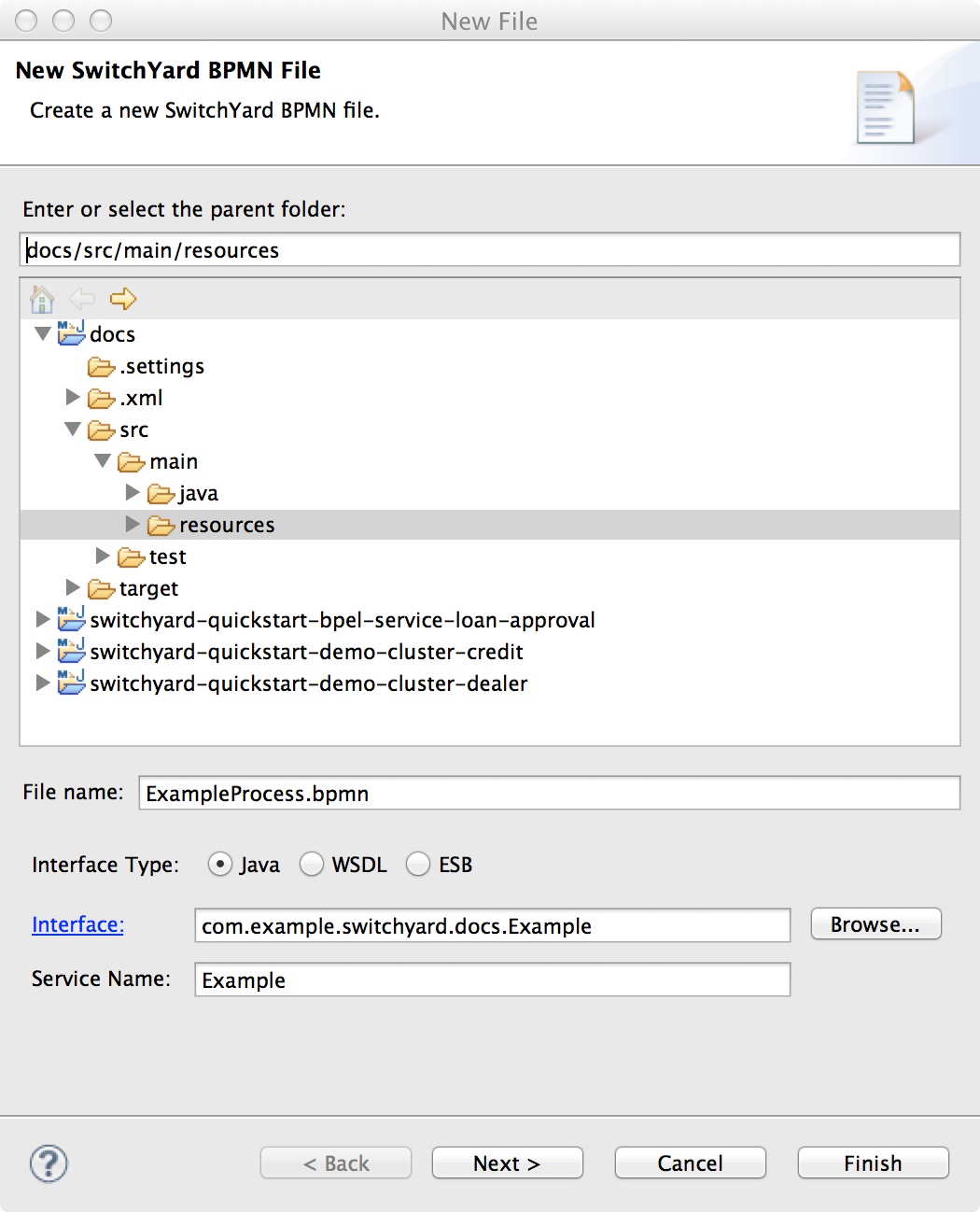
After clicking Finish, you will have a new service component definition for your process service and an empty BPMN process definition. The next phase in developing your BPM service is to author the BPMN 2 process definition (details outside the scope of this documentation) and then configure the BPM service component to interact with that process definition.
Process Interaction
Interaction with a process is defined via actions on a BPM service component. Take the following service contract as an example:
package org.switchyard.userguide;
public interface MyService {
public void start(String data);
public void signal(String data);
public void abort(String data);
}
Actions allow you to map an operation in the service contract to one of the following interactions with a business process:
-
START_PROCESS
-
SIGNAL_EVENT
-
SIGNAL_EVENT_ALL
-
ABORT_PROCESS_INSTANCE

Starting a Process Instance
Operations configured with the START_PROCESS action type will start new process instances.
When you start your process (actually, any interaction with a service whose implementation is bpm), the processInstanceId will be put into the Switchyard Context at Scope.MESSAGE, and will be fed back to your client in a binding-specific way. For soap, it will be in the form of a soap header in the soap response envelope:
<soap:Header>
<bpm:processInstanceId xmlns:bpm="urn:switchyard-component-bpm:bpm:1.0">1</bpm:processInstanceId>
</soap:Header>
In future process interactions, you will need to send back that same processInstanceId, so that the correlation is done properly. For soap, that means including the same soap header that was returned in the response to be sent back with subsequent requests.
If you are using persistence, the sessionId will also be available in the Context, and will need to be fed back as well. It would look the same way in the soap header as the processInstanceId does.
Correlation Keys
If you do not want to track the processInstanceId, however need to have multiple interactions with the same process instance, you can start the process with your own application-specific correlation key, and include that same correlation key for future interactions. Here is an example of including in a a soap request:
<soap:Header>
<bpm:correlationKey xmlns:bpm="urn:switchyard-component-bpm:bpm:1.0">MY-APP-KEY-0123456789</bpm:correlationKey>
</soap:Header>
Signaling a Process Instance
Operations configured with the SIGNAL_EVENT operation type will have the associated process instance signaled. As above, the processInstanceId will need to have been available in the Context so the correct process instance is correlated.
There are two other pieces of information when signaling an event:
-
The "event id". In BPMN2 lexicon, this is known as the "signal id", but in jBPM can also be known as the "event type". This is set as the eventId in the configuration.
-
Note: In BPMN2, a signal looks like this: <signal id="foo" value="bar"/> In jBPM, it is the signal id that is respected, not the name. This might require you to tweak a tooling-generated id to whatever you want it called.
-
-
The "event object". This is the data representing the event itself, coming from the Message content object itself (your payload).
Operations configured with the SIGNAL_EVENT_ALL operation type will have all process instances signaled.
Aborting a Process Instance
Operations configured with the ABORT_PROCESS_INSTANCE operation type will cause associated process instances to be aborted. As above, the processInstanceId will need to have been available in the Context so the correct process instance is correlated.
Operation Mappings
SwitchYard provides a flexible way to map data in and out service operation invocations via MVEL expressions. First, please familiarize yourself with the general Knowledge Services documentation, specifically the sections related to what Globals, Faults, Inputs and Outputs are. Next, consider the following tooling screenshot:
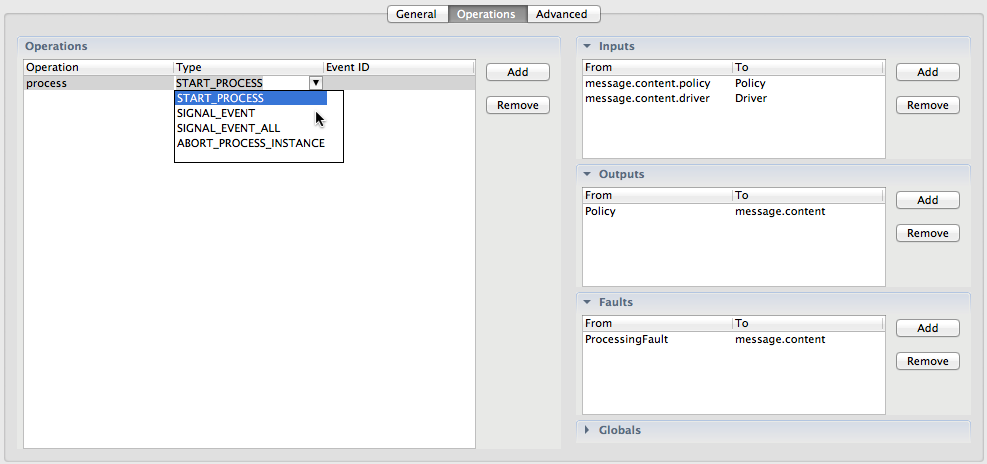
The above will create XML configuration like this:
<operation name="process" type="START_PROCESS">
<inputs>
<input from="message.content.policy" to="Policy"/>
<input from="message.content.driver" to="Driver"/>
</inputs>
<outputs>
<output from="Policy" to="message.content"/>
</outputs>
<faults>
<fault from="ProcessingFault" to="message.content"/>
</faults>
</operation>
Globals
If your process executes business rules, you can use global mappings to access data in your rules which do not trigger rule execution themselves.
Inputs
For the BPM component, inputs are used to set process instance variables that can later be referenced by nodes within your process.
For you to be able to use variables inside your process, you have to declare your variable names at the process level, as well as in the Parameter Mapping (and possibly Result Mapping) of any process node that wants access to those variables. This can be done easily in the BPMN2 Eclipse tooling by using the Properties view when clicking on either the whitespace around the process, or on any of your process nodes.
Outputs
Outputs are used to extract process instance variables so that they can be set in the outgoing SwitchYard Message content.
Faults
Fault mapping is similar to Output mapping, however the data represents an Exception or data that will be wrapped in an Exception.
Consuming a Service
There are two ways of consuming Services with the SwitchYard BPM component:
-
Invoking the BPM implementation through a gateway binding. Since the BPM component exposes a java interface fronting the business process, you can use any of the bindings provided by SwitchYard. This could be a SOAP Binding or a Camel Binding, for example. (Please refer to those sections of this guide for more information.)
-
Invoking other SwitchYard Services from inside a BPM process itself. To do this, you can use the SwitchYardServiceTaskHandler, which is provided out-of-the-box, and auto-registered with the runtime. To make authoring BPMN2 processes easier, SwitchYard provides a new widget for the Eclipse BPMN2 Modeler visual editor palette. Here is a screenshot from the "Help Desk" demo quickstart:
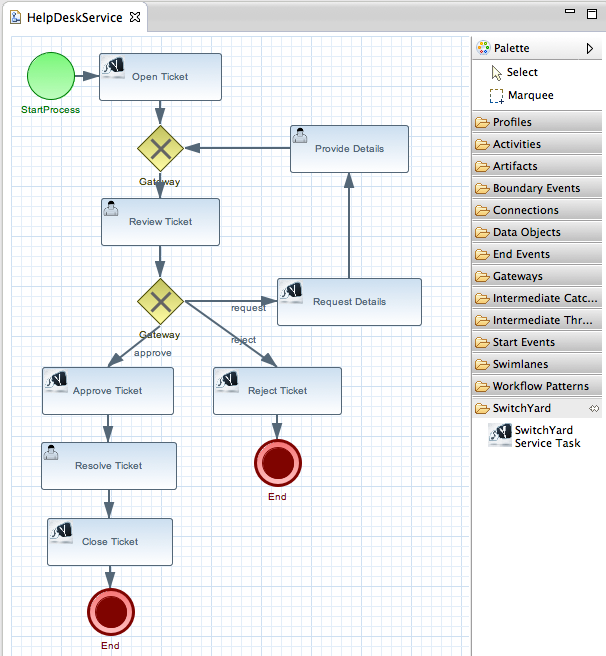
SwitchYard Service Task
On the bottom right hand side under "Custom Task", you can see the SwitchYard Service widget. On the left hand side, you can see the various points of the business process where SwitchYard Services are being invoked. Once you have dropped a SwitchYard Service task in the main window, you can customize it via the Eclipse Properties Editor:
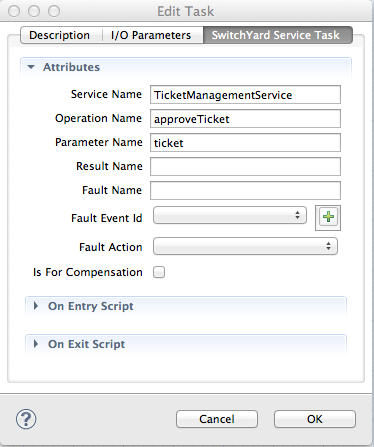
SwitchYard Service Task Properties
The following are properties you can use to configure the SwitchYard Service task (a.k.a. the "Dynamic" SwitchYard Service task):
Service Naming Properties
-
ServiceName: (required) The name of the SwitchYard service to invoke.
-
OperationName: (optional; default=use the single method name in the service interface, if there is just one) The name of the operation within the SwitchYard service to invoke.
Content I/O Properties
-
ParameterName: (optional; default=Parameter) The process variable which the message content will be placed in.
-
ResultName: (optional; default=Result) The process variable which the message content will be gotten from.
Fault-Handling Properties (see SwitchYard Service Fault Handling below)
-
FaultName: (optional; default=Fault) The name of the output parameter (result variable) the fault (Exception) will be stored under.
-
FaultEventId: (optional) The bpmn signal id ("event type" in jbpm lingo) that will be used to signal an event in the same process instance. The event object will be the fault (Exception). Please see Signaling a Process above.
-
FaultAction: (optional; default=throw) After a fault occurs, what should be done? If null or throw, an exception is thrown. If complete, the current work item (SwitchYard Service task) is completed. If abort, the current work item is aborted. If skip, nothing is done.
You can read a more detailed explanation of the Help Desk quickstart demo, as well as how to set up Eclipse to make use of new widget, on this wiki page.
SwitchYard Service Fault Handling
During your process execution, the SwitchYardServiceTaskHandler class is used to handle Switchyard Service tasks. It executes service references, per the properties specified in the panel above. Pay particular attention to the list of Fault-Handling Properties. These properties define the behavior of the SwitchYardServiceTaskHandler in the case were a fault is encountered when executing the service reference. There are 3scenarios that the fault-handling covers:
-
"In my process flow, after the SwitchYard Service task, I would like a split gateway where I can inspect a process variable (a "flag") that can tell me that a fault occurred, so that I can diverge one way or another."
-
To do this, specify the FaultName property. The SwitchYardServiceTaskHandler will make the fault itself available as an output parameter of the task, so that it can be associated with a process variable, and inspected for existence in your split gateway. You must also set the FaultAction property to complete, so that the process will continue on to your split gateway!
-
An example bpmn2 process can be found in our JUnit test suite here: BPMServiceTests-FaultResultProcess.bpmn
-
-
"In my process flow, I have multiple places where faults could occur, and I want to have one shared path of fault-handling."
-
To do this, specify the FaultEventId property. This must match a signal id you specify in your bpmn2 process definition. You can then add an event node in your process that is triggered with this signal id; the flow from that event node on is your fault-handling path. The SwitchYardServiceTaskHandler will then signal the proper event with the configured id.
-
An example bpmn2 process can be found in our JUnit test suite here: BPMServiceTests-FaultEventrocess.bpmn
-
-
"In my process flow, I want to bubble an Exception back out to the process, so it can be handled with a boundary event."
-
This is the default behavior, but to explicitly declare this, set the FaultAction property to throw, so that an exception will be thrown.
-
Whether which scenario above you choose, the question remains "What next?" If you don't specify a FaultAction property, it is the same as setting it to throw. If you set the property to skip, the work item is not completed, nor is it aborted. You can set the property to complete to complete the work item after a fault, or you can set the property to abort to abort the work item after a fault.
Using the standard BPMN2 Service Task
It is possible to invoke SwitchYard Services using the standard BPMN2 Service Task <serviceTask>. It is conceptually similar, however you will use the Service Task icon from the BPMN2 Editor palette, and configure it slightly differently:
-
The <serviceTask> knows to invoke SwitchYard when it has an implementation="##SwitchYard" attribute.
-
The ServiceName is derived from the BPMN2 interface or interfaceImplementationRef.
-
The OperationName is derived from the BPMN2 operation or operationImplementationRef.
-
The ParameterName is always called Parameter.
-
The ResultName is always called Result.
Resources
A Resource represents an artifact that is required by your BPM process. It could be anything you could think of, including a properties file, a Drools Rule Language file, or whatever. But it needs to be available to the BPM component's runtime for that process. The list of resources available to your process is a configurable aspect of the BPM service component.

WorkItem Handlers
A WorkItemHandler is a way for you to add your own code into the business process. Simply implement the org.kie.api.runtime.process.WorkItemHandler interface and add it to your BPM service component.
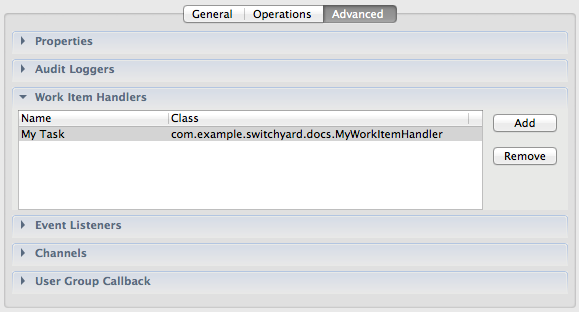
By default, the SwitchYardServiceTaskHandler is always added for you by the SwitchYard Maven plugin. That handler allows you to easily call out to other SwitchYard services by name within your business process. Please see the section "Consuming a BPM Service" below for more information.
User/Group Callbacks
A UserGroupCallback is a way for you to specify how to access user and group information. jBPM provides several implementations out of the box, including ones for DB, JAAS, Properties, LDAP and MVEL. Simply implement the org.kie.internal.task.api.UserGroupCallback interface and add it to your BPM service component.
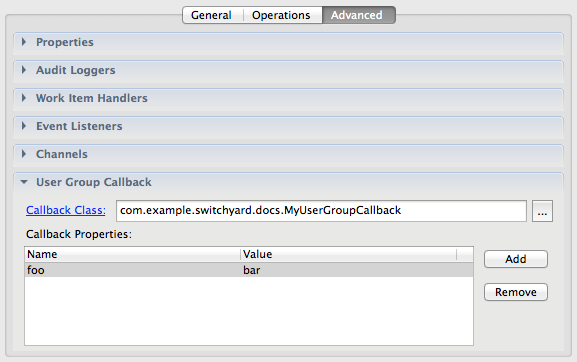
Auditing a Process
Please see the Listeners and Loggers sections found in the Knowledge Services documentation.
Rules Services
Overview
The Rules Component is a pluggable container in SwitchYard which allows business rules to be exposed as a service. One fronts their rules with a custom interface and, if desired, can easily annotate it's methods to define which should execute the rules. The Rules Component currently supports Drools as the rule engine. Even though it is quite simple to write rules in Drools, that project's developer tooling and business analyst tooling are very mature.
A Rules Service is a type of Knowledge Service (the other type being a BPM Service). Thus, it is strongly suggested you familiarize yourself with the shared configuration capabilities of Knowledge Services.
Creating a Rules Service
To create a new Rules service in SwitchYard, you'll need the following information
-
File Name : the file name that will be used to create a new template rules definition.
-
Interface Type : the contract for the service being provided. Rules services support Java, WSDL, and ESB contract types.
-
Service Name : the name of the service your process will provide.
-
Package Name : package name used for the new Rules file.

The MyService interface can be as simple as this, with no SwitchYard-specific imports:
package com.example.switchyard.docs;
public interface Example {
public void process(MyData data);
}
The generated rule template will look like this:
package com.example.switchyard.docs
import org.switchyard.Message
global Message message
rule "RulesExample"
when
// insert conditional here
then
// insert consequence here
System.out.println("service: ExampleService, payload: " + message.getContent());
end
Operation Mappings
SwitchYard provides a flexible way to map data in and out service operation invocations via MVEL expressions. First, please familiarize yourself with the general Knowledge Services documentation, specifically the sections related to what Globals, Faults, Inputs and Outputs are. Next, consider the following tooling screenshot:
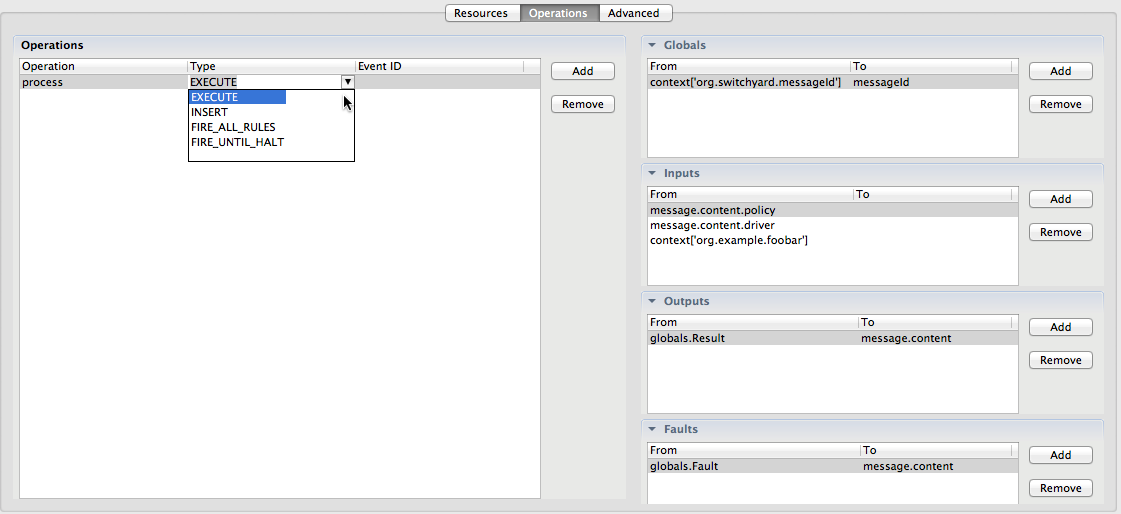
The above will create XML configuration like this:
<operation name="process" type="EXECUTE">
<globals>
<global from="context['org.switchyard.messageId']" to="messageId"/>
</globals>
<inputs>
<input from="message.content.policy"/>
<input from="message.content.driver"/>
<input from="context['org.example.foobar']"/>
</inputs>
<outputs>
<output from="globals.Result" to="message.content"/>
</outputs>
<faults>
<fault from="globals.Fault" to="message.content"/>
</faults>
</operation>
The associated DRL could look like this:
package org.switchyard.example.docs
global java.lang.String messageId
global java.util.Map globals
rule "Approval"
when
policy : Policy(threshold >= 600)
then
policy.setFlag(true);
globals.put("Result", policy);
end
rule "Denial"
when
policy : Policy(threshold < 600)
then
policy.setFlag(false);
globals.put("Result", policy);
end
Globals
Globals represent variable in your rules that do not trigger rule execution, but can be used in either the LHS or RHS of your rules for customization. They also provide a nice way to define in/out "buckets" so you can get data out of rule execution. In the example above, the messageId is a global variable, and a Map (called "globals") is as well. This way, we can set the outgoing SwitchYard Message content to the modified Policy.
The global variable called globals (java.util.Map) is always available for in/out purposes. You don't have to configure it in your <globals> section for it to be available to your DRL. (See above.)
If you want to use your own application object as in in/out variable, you are free to do so.
You can even dynamically create your own Map using MVEL and name it what you want. For example, "holder" as shown below:
<operation name="process" type="EXECUTE">
<globals>
<!-- the from is an MVEL construct which creates a new Map -->
<global from="['':'']" to="holder"/>
</globals>
<outputs>
<!-- this assumes your DRL did a holder.put("out", someObject) at some point -->
<output from="holder.out" to="message.content"/>
</outputs>
</operation>
Inputs
For the Rules component, Inputs are the "facts" that are inserted into the Drools rules engine. In the example above, a Policy object, a Driver object, and a Context property. The rules engine will react to these inserted objects, building an agenda so that the appropriate RHS clauses will execute.
If you do not specify your own Inputs, the default will be the incoming Message content. If you do specify your own Inputs, the incoming Message content will not be inserted as a fact, and you will have to include "message.content" yourself, if desired.
Outputs
Using in/out variables (for example, the global Map called "globals"), we can extract data out of the rules execution and into the outgoing Message content.
If you do not specify your own Outputs, the default will be the result of the expression "globals.Result".
If you do not specify your own Outputs, or in your DRL, you do not populate the "Result" of the globals Map, then your Rules component execution will return null. For IN_OUT Exchange patterns, this could obviously be a problem, so in those cases make sure you configure (or populate the default) Output correctly!
Faults
Fault mapping is similar to Output mapping, however the data represents an Exception or data that will be wrapped in an Exception.
Stateless vs. Stateful Rules Execution
By default, service method invocation will create a new Drools knowledge session, execute it given the passed-in domain data, and then be cleanly disposed.
However, it is possible to configure SwitchYard so that a stateful knowledge session will be used. Specifically, it will "stick around" spanning multiple invocations. (Please visit the Drools documentation to learn more about stateless vs. stateful knowledge sessions.) To do this, you use the FIRE_ALL_RULES action type instead of EXECUTE.
There is also a new capability which allows you to insert facts into a stateful knowledge session without firing the rules (you might want to do that later). In this case, use the INSERT operation type.
Complex Event Processing
Complex Event Processing, or "CEP", is an advanced topic, and can best be explained in the Drools Fusion documentation. What will be shown here in the SwitchYard documentation is how it can be configured via XML. Obviously this can be set using the Eclipse tooling as well.
<implementation.rules ...>
<operations>
<operation eventId="FooStream" name="processFooMessage" type="FIRE_UNTIL_HALT"/>
<operation eventId="BarStream" name="processBarMessage" type="FIRE_UNTIL_HALT"/>
</operations>
...
<properties>
<property name="drools.clockType" value="realtime"/>
<property name="drools.eventProcessingMode" value="stream"/>
<property name="drools.maxThreads" value="1"/>
<property name="drools.multithreadEvaluation" value="false"/>
</properties>
</implementation.rules>
Note the type of "FIRE_UNTIL_HALT". This is required for CEP scenarios.
How do facts (data) get inputted for CEP?
Operations of type FIRE_UNTIL_HALT can specify <inputs> just like any other operation. If all of your inputs have "from" attributes but not "to" attributes, then:
-
If the "eventId" attribute on the operation element is set, then the eventId is your entry point that the data gets inserted into.
-
If the "eventId" attribute on the operation element is not set, then everything gets inserted into the stateful session, not into an entry point (as we can't guess that for you).
In other words, if you have input elements with "to" attributes, then the value of the "to" attribute will override - for just those input elements - what is set as "eventId" on the operation element. The point of this is that with just one operation invocation, you can have a list of different inputs, and whatever facts come from each input can be targeted to different entry points. Again, all with one operation invocation. Any inputs without to attributes in that operation will default to the operation's eventId, and if there is no eventId, again it defaults up again to be inserted into the stateful session itself.
Resources
A Resource represents an artifact that is required by your Rules component. It could be anything you could think of, including a properties file, a Drools Rule Language file, or whatever. But it needs to be available to the Rules component's runtime for that process. The list of resources available to your process is a configurable aspect of the Rules service component.
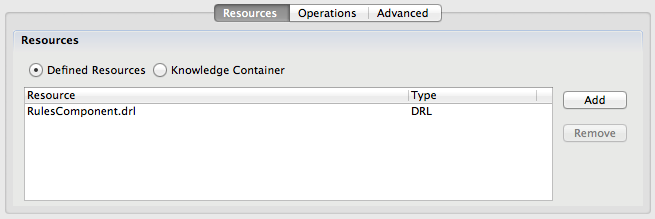
Decision Tables
If your resource type is decision table (DTABLE), then you have the option of also specifying additional information for that resource using the resourceDetail sub-element:
-
If the decision table is an eXcel spreadsheet (XLS), or a Comma Separated Value (CSV) file, you can use the "inputType" attribute.
-
If it is a spreadsheet, to use a specifically named tab (or "sheet") in it, you can use the "worksheetName" attribute.For example:
<resource location="META-INF/Example.xls" type="DTABLE">
<resourceDetail inputType="XLS" worksheetName="Sheet 2"/>
</resource>
Auditing a Service
Please see the Listeners and Loggers sections found in the Knowledge Services documentation.
Consuming a Service
Please see the Channels section found in the Knowledge Services documentation.
BPEL Services
The BPEL Component is a pluggable container in SwitchYard which allows a WS-BPEL business process to be exposed as a service through an interface defined using WSDL.
Providing a Service
To provide a service with the BPEL component, you will have to:
-
Define your process using WS-BPEL (e.g. using the Eclipse BPEL editor bundled with JBossTools).
-
Define a WSDL interface for the BPEL service.
-
Define a Deployment Descriptor (e.g. using the ODE Deployment Descriptor editor bundled with JBossTools).
-
Add the component containing the implementation and service interface to the SwitchYard configuration.
Here is an example of the component section of the SwitchYard configuration:
<sca:component name="SayHelloService">
<bpel:implementation.bpel process="sh:SayHello" />
<sca:service name="SayHelloService">
<sca:interface.wsdl interface="SayHelloArtifacts.wsdl#wsdl.porttype(SayHello)"/>
</sca:service>
</sca:component>
The BPEL component contains a single 'implementation.bpel' element that identifies the fully qualified name of the BPEL process.
The component may also contain one or more service elements defining the WSDL port types through which the BPEL process can be accessed.
In the packaged Switchyard application, the BPEL process associated with this fully qualified name, must be present within the root folder of the distribution, along with the deployment descriptor (deploy.xml). The service name specified must match the component service name declared in the switchyard.xml. The port field is not used. An example of the deployment descriptor for the BPEL process referenced above is:
<deploy xmlns="http://www.apache.org/ode/schemas/dd/2007/03"
xmlns:examples="http://www.jboss.org/bpel/examples"
xmlns:domain="urn:switchyard-quickstart:bpel-say-hello:0.1.0">
<!-- say_hello example -->
<process name="examples:SayHello">
<active>true</active>
<retired>false</retired>
<process-events generate="all"/>
<provide partnerLink="client">
<service name="domain:SayHelloService" port="ignored"/>
</provide>
</process>
</deploy>
Consuming a Service
This section describes how a BPEL process can invoke other services.
The first step is to define the WSDL interface(s), representing the service(s) to be consumed, using an invoke element within the deployment descriptor. Once again, the service name must match the name of the component reference in the switchyard.xml, e.g.
<deploy xmlns="http://www.apache.org/ode/schemas/dd/2007/03"
xmlns:ls="http://example.com/loan-approval/loanService/"
xmlns:ra="http://example.com/loan-approval/riskAssessment/"
xmlns:examples="http://www.jboss.org/bpel/examples"
xmlns:domain="urn:switchyard-quickstart:bpel-loan-approval:0.1.0">
<!-- loan_approval/loanService example -->
<process name="ls:loanApprovalProcess">
<active>true</active>
<process-events generate="all"/>
<provide partnerLink="customer">
<service name="domain:loanService" port="ignored"/>
</provide>
<invoke partnerLink="assessor" usePeer2Peer="false">
<service name="domain:riskAssessor" port="ignored"/>
</invoke>
</process>
<!-- loan_approval/riskAssessment example -->
<process name="ra:riskAssessmentProcess">
<active>true</active>
<process-events generate="all"/>
<provide partnerLink="assessor">
<service name="domain:riskAssessor" port="ignored"/>
</provide>
</process>
</deploy>
The 'usePeer2Peer' property informs the BPEL engine not to use internal communications for sending messages between BPEL processes that may be executing within the same engine, and instead pass messages through the SwitchYard infrastructure.
For each consumed service, we then need to create a reference element within the SwitchYard configuration, to locate the WSDL file and identify the port type associated with the required WSDL service/port.
<sca:component name="loanService">
<bpel:implementation.bpel process="ls:loanApprovalProcess" />
<sca:service name="loanService">
<sca:interface.wsdl interface="loanServicePT.wsdl#wsdl.porttype(loanServicePT)"/>
</sca:service>
<sca:reference name="riskAssessor" >
<sca:interface.wsdl interface="riskAssessmentPT.wsdl#wsdl.porttype(riskAssessmentPT)"/>
</sca:reference>
</sca:component>
Implementation Property Injection
You can inject properties into your BPEL process definition with using SwitchYardPropertyFunction.resolveProperty() XPath custom function. This bpel:copy section copies "Greeting" property value into the ReplySayHelloVar variable:
.....
<bpel:copy>
<bpel:from xmlns:property="java:org.switchyard.component.bpel.riftsaw.SwitchYardPropertyFunction"
expressionLanguage="urn:oasis:names:tc:wsbpel:2.0:sublang:xpath2.0">
<![CDATA[concat(property:resolveProperty('Greeting'), $ReceiveSayHelloVar.parameters/tns:input)]]>
</bpel:from>
<bpel:to part="parameters" variable="ReplySayHelloVar">
<bpel:query queryLanguage="urn:oasis:names:tc:wsbpel:2.0:sublang:xpath1.0"><![CDATA[tns:result]]></bpel:query>
</bpel:to>
</bpel:copy>
See Properties section of the User Guide for more details of SwitchYard property support.
Maintain Multiple Versions of a BPEL Process
BPEL processes can be used to implement long lived stateful business processes. However the BPEL process may need to change, over the course of its lifetime, to accomodate new requirements.
This introduces the problem of how to deal with existing active instances of the BPEL process that may not complete for weeks, months or even years. In these situations we need to have a strategy for dealing with multiple version of a BPEL process, to enable new requirements to be introduced, while still preserving the original process definitions associated with existing active process instances.
This is achieved by simply associating a version number with the BPEL process by adding it as a suffix to the BPEL file name. For example, if our BPEL process would normally be located in the file 'HelloWorld.bpel', then we simply add a hyphen followed by the version number, e.g. 'HelloWorld-32.bpel' would indicate that this is the 32nd version of this BPEL process.
When a new version of the BPEL process has been defined, it is packaged in the SwitchYard application, along side the previous versions of the BPEL process. It is important that the older version of the BPEL process remain in the SwitchYard application until there are no longer any active process instances associated with that version.
![]() It is then important that the SwitchYard application is re-deployed, without undeploying the previous version. If the previous version of the SwitchYard application is undeployed, it will cause the BPEL engine to delete all outstanding active instances associated with the process definitions that have bene removed.
It is then important that the SwitchYard application is re-deployed, without undeploying the previous version. If the previous version of the SwitchYard application is undeployed, it will cause the BPEL engine to delete all outstanding active instances associated with the process definitions that have bene removed.
Although the BPEL process is versioned, the WSDL interfaces are not. It is important to ensure that any changes made to the WSDL interfaces are backward compatible, so that both the new and older versions of the BPEL (that still have active process instances) are not affected by the changes.
Structure of a SwitchYard BPEL Application
The following image shows the structure of the say_hello SwitchYard BPEL quickstart:

The important part is how the artifacts are structured within the src/main/resources folder.
The switchyard.xml configuration file is located in the META-INF folder as usual. However the BPEL deployment descriptor (deploy.xml), and the BPEL process definition are located in the root folder.
The WSDL interface definitions, and any accompanying XSD schemas, can be located in sub-folders. If they are, then the BPEL process and SwitchYard BPEL component configuration must define the correct relative path.
Knowledge Services
Knowledge Services are SwitchYard Services that leverage KIE, and thus, Drools and/or jBPM:
Given that Drools and jBPM are very tightly integrated under KIE, much of their runtime configuration can be shared by both SwitchYard's BPM component and its Rules component. Therefore, documentation on this page refers to elements that are either exactly, or structurally, identical to both the BPM and Rules components. That is to say, any configuration element you see here can be used in the same way for both BPM and Rules. Sometimes, however, the context of the element is significant, so cases like that will be identified where applicable.
For some of the configuration elements below, you might wonder why it is a shared element between both the BPM and Rules components. For example, Channels are something only applicable to Rules, right? Yes, however what if your BPM process has a node which executes business rules, and those rules reference channels? In that case, you need a way to configure channels for the rules within your process. Thus, it is documented here.
Operations
Operations are how Knowledge Services know how to map service operation invocations to their appropriate runtime counterparts. For example, when method "myOperation" is called, what should happen? Execute some business rules? Start a business process?
Using the XML below as reference, when the SwitchyYard service’s "myOperation" operation is invoked, an operation of type "OPERATION_TYPE" will be taken. Note that "OPERATION_TYPE" is just a placeholder here. Actual OperationTypes are specific to the BPM and Rules components. Please refer to the specific documentation on those pages.
At this time, the eventId attribute is only applicable to the Rules component.
Please see the Mapping section below for an explanation of the globals, inputs, outputs and faults sections.
XML
<operations>
<operation eventId="myEventId" name="myOperation" type="OPERATION_TYPE">
<globals>
<global from="" to=""/>
</globals>
<inputs>
<input from="" to=""/>
</inputs>
<outputs>
<output from="" to=""/>
</outputs>
<faults>
<fault from="" to=""/>
</faults>
</action>
</operations>
Mappings
Mappings are the way to move data in or out of an operation. You can specify as many mappings as you like for an operation, and they get grouped as globals, inputs, outputs or faults:
-
Global mappings are used to provide data that is applicable to the entire action, and is often used in classic in/out param (or data-holder/provider) fashion. An example of a global mapping is a global variable specified within a Drools Rule Language (DRL) file.
-
Input mappings are used to provide data that represents parameters being fed into an action. An example of an input mapping for BPM could be a process variable used while starting a business process. For Rules, it could be a fact to insert into a rules engine session.
-
Output mappings are used to return data out of an action. An example of an output mapping would be a BPM process variable that you want to set as the outgoing (response) message’s content.
-
Fault mappings are used to return fault data out of an action. An example of a fault mapping would be a BPM process variable that you want to set as the outgoing (response) application Exception to be thrown.
All of the different mapping types support a from and to attribute. Those attributes get configured with MVEL expressions, which themselves support variables that can come from process or global variable names, implicit variable names (see below), or variables that get resolved from properties.
Implicit Variables
-
context - The current org.switchyard.Context.
-
message - The current org.switchyard.Message.
Some examples:
-
from="message.content" - This is the same as message.getContent().
-
from="context[‘foo’]" - This is the same as context.getProperty("foo", Scope.MESSAGE).getValue(), in a null-safe manner.
Specifying attributes is often optional, but this depends on the usage. For example, if you are specifying a global variable for a rule, or a process variable to put into (or get out of) a BPM process, then it is required. However, if the result of the expression is to be used as facts for rule session insertion, than specifying a "to" isn’t applicable.
Channels
Drools supports the notion of "Channels", which are basically "exit points" in your DRL. They can be used in both stateful and stateless sessions. Here is an example:
package com.example
rule "example rule"
when
$f : Foo ( bar > 10 )
then
channels["Bar"].send( $f.getBar() );
end
XML
<channels>
<channel class="com.example.BarChannel" name="Bar"/>
</channels>
Channels must implement org.kie.api.runtime.Channel.
SwitchYard Service Channel
SwitchYard provides an out-of-the-box Channel which allows you to invoke (one-way) other SwitchYard services directly and easily from your DRL. Here is an example:
XML
<channel name="HelloWorld" reference="HelloWorld" operation="greet"/>
Attribute Reference:
-
class = The channel implementation class. (Default is SwitchYardServiceChannel.)
-
name = The channel name. (default = simple name of the implementation class)
-
reference = The service reference qualified name.
-
operation = The service reference operation name.
Listeners
Listeners are used to monitor specific types of events that occur during Knowledge execution. An example of this would be to audit a BPM process, and save the audit details into a database while the process progresses. Then at a later time, these details can be reported against. There are many out-of-the-box Listeners that Drools and jBPM provide, and you can write your own. The only restriction in writing your own Listener is that it must, at the minimum, implement java.util.EventListener. However, your Listener won’t actually be registered for anything unless it also implements one of the respected KIE/Drools/jBPM Listener interfaces. For example, org.drools.core.event.WorkingMemoryEventListener, org.kie.api.event.rule.AgendaEventListener, org.kie.api.event.process.ProcessEventListener, or similar.
If the Listeners provide a Constructor taking a single KieRuntimeEventManager (or KnowledgeRuntimeEventManager) as a parameter, that is used and it is assumed it will do the work of registering itself with the passed-in event manager (OOTB {{WorkingMemoryLogger}}s do this). Otherwise, a no-arg constructor is assumed, and SwitchYard will do the work of registering the Listeners for each of the respected interfaces it implements.
XML
<listeners>
<listener class="org.drools.core.event.DebugProcessEventListener"/>
<listener class="org.kie.api.event.rule.DebugWorkingMemoryEventListener"/>
<listener class="com.example.MyListener"/>
</listeners>
Loggers
Loggers are special types of Listeners, and are used to output the events that occur during Knowledge execution. Support for Loggers is done using a dedicated configuration element. Events can be logged to the CONSOLE or to a FILE (or THREADED_FILE). If they are directed to a file, that log can later be opened via the Drools Eclipse tooling.
XML
<loggers>
<logger interval="2000" log="myLog" type="THREADED_FILE"/>
<logger type="CONSOLE/>
</loggers>
Manifest
The only configuration element more important than Operations is the Manifest, which is where you specify where the "intelligence" of the component comes from. For the BPM component, this will be, at the minimum, the location of the BPMN 2 process definition file. For the Rules component, this will most likely be the location of DRL, DSL, DSLR or XLS files. There are two ways to to configure the Manifest:
-
With a KIE Container. This relies upon the existence of a META-INF/kmodule.xml configuration file.
-
With a manually defined list of Resources.
These two options are mutually exclusive: You have to choose one or the other!
The following examples assume there is a DRL file located at classpath: com/example/MyRules.drl
Option 1 (KIE Container):
META-INF/kmodule.xml
<kmodule xmlns="http://jboss.org/kie/6.0.0/kmodule">
<kbase name="com.example">
<ksession name="my-session"/>
</kbase>
</kmodule>
XML
<manifest>
<container sessionName="my-session"/>
</manifest>
In addition to the sessionName attribute, you can also specify baseName and releaseId, if desired.
Also, scanning for updates is supported only with the container option (not the resources option). To enable this, simply set scan="true" and, optionally, scanInterval=<# of milliseconds>.
Option 2 (Resources):
XML
<manifest>
<resources>
<resource location="com/example/MyProcess.bpmn" type="BPMN2"/>
<resource location="com/example/MyRules.drl" type="DRL"/>
</resources>
</manifest>
Properties
Properties are the way to provide "hints" to the underlying KIE/Drools/jBPM runtime on how certain options are configured. Rather than having to expose every single KIE/Drools/jBPM option as a configurable element or attribute within SwitchYard, they can be set as open-ended properties.
Properties are an advanced topic, so setting them should be done with care. All possible property names and values will not be listed here, but as a starting point, in your IDE open up a Type Heirarchy with a root of org.kie.api.conf.Option. That is your full list. Here are just a couple examples:
XML
<properties>
<property name="drools.clockType" value="pseudo"/>
<property name="drools.eventProcessingMode" value="stream"/>
</properties>